Posts Tagged ‘significant trees’
Monday, January 16th, 2012
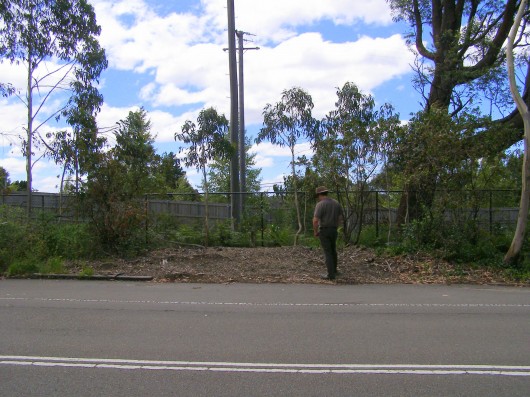 The site of Blue Mountains Significant Tree #5 – it was a massive Eucalyptus oreades
~ Our endemic heritage woodchipped into oblivion
Lest we forget!
(Photo of Editor 20120111, free in public domain, click photo to enlarge) The site of Blue Mountains Significant Tree #5 – it was a massive Eucalyptus oreades
~ Our endemic heritage woodchipped into oblivion
Lest we forget!
(Photo of Editor 20120111, free in public domain, click photo to enlarge)
.
This mature native tree was respected enough to have been listed on Blue Mountain Council’s Significant Tree Register. Indeed it was the 5th such listed tree on Blue Mountains Council’s Register of Significant Trees back in 1988.
So what is the meaning of a ‘Significant Tree‘ on Blue Mountains Council’s register?
Well back on 21st June 1988 the Register of Significant Trees was adopted by Blue Mountains Council as an integral part of its Development Control Plan, which proclaimed significant trees be protected under Clause 6 ‘Protection of Items Listed in the Register of Significant Trees‘ so that:
.
‘No person shall ringbark, cut down, top, lop, injure, wilfully destroy or cause damage to the root system off any tree listed on the Register of Significant trees without consent of Council.’
.
Perhaps the current Blue Mountains Council mayor may care to publicly explain why its Significant Tree Number 5, a locally endemic Eucalyptus oreades (Blue Mountains Ash) of some stature located opposite 252 Old Bathurst Road Katoomba (Lot 2 DP707) has been woodchipped into oblivion?
- Was formal Blue Mountains Council consent given to kill it?
- If so, when was this Blue Mountains Council consent given to kill it?
- What Blue Mountains Council documentation is publicly available to validate such consent?
- What public notice was provided by Blue Mountains Council for community consultation about its killing?
- Does Blue Mountains Council give a bleeding toss?
.
The objectives of Blue Mountains Council’s Significant Tree Register include:
.
(a) identify and protect those trees listed on the Register
(b) promote greater public awareness of the existence of the Register, and the individual items listed
(c) ensure existing and, importantly, prospective land owners, are made aware of the Significant Trees which may be located on their property
(d) ensure correct on-going care and maintenance of those trees listed, through the recommendations included with the significant tree register
.
The following tree is not even on the Blue Mountains Council Significant Tree Register, so has even less chance of protection.
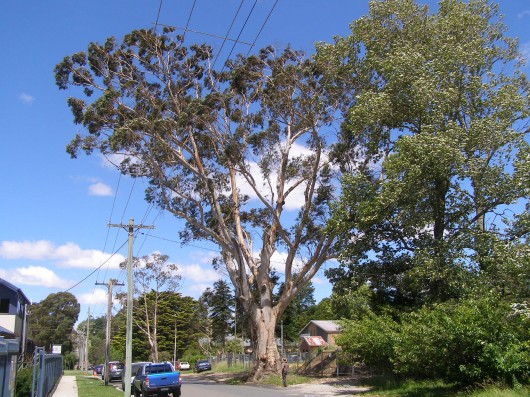 Katoomba’s most significant (grandfather) Eucalyptus oreades, beside Megalong Street
Pitifully it manages to survive as an extremely rare relic of the once magnificent Oreades Forest
This tree is ‘endemic’ to the Central Upper Blue Mountains at Katoomba
(That is, it grows naturally nowhere else on the friggin Planet!)
(Photo of Editor 20120111, free in public domain, click photo to enlarge) Katoomba’s most significant (grandfather) Eucalyptus oreades, beside Megalong Street
Pitifully it manages to survive as an extremely rare relic of the once magnificent Oreades Forest
This tree is ‘endemic’ to the Central Upper Blue Mountains at Katoomba
(That is, it grows naturally nowhere else on the friggin Planet!)
(Photo of Editor 20120111, free in public domain, click photo to enlarge)
.
But this tree is perpetually being subjected by Blue Mountains Council approved industrial development after industrial development – the road widening, the recent expansion of the bus depot across the road and now some ‘mega industrial’ estate behind it. Blue Mountains Council pro-development forces are mounting against it.
.
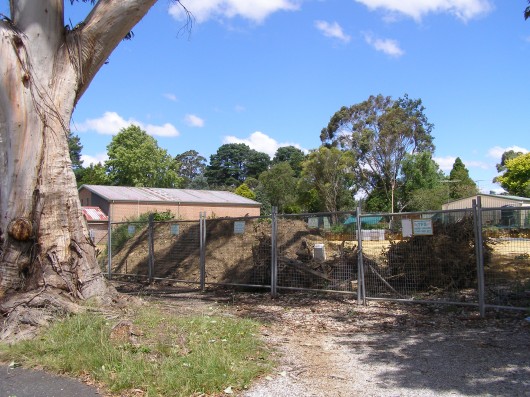 The Mega industrial development immediately behind this magnificent native tree
~ but what would BMCC care?
(Photo by Habitat Investigator 20120111, free in public domain, click photo to enlarge) The Mega industrial development immediately behind this magnificent native tree
~ but what would BMCC care?
(Photo by Habitat Investigator 20120111, free in public domain, click photo to enlarge)
.
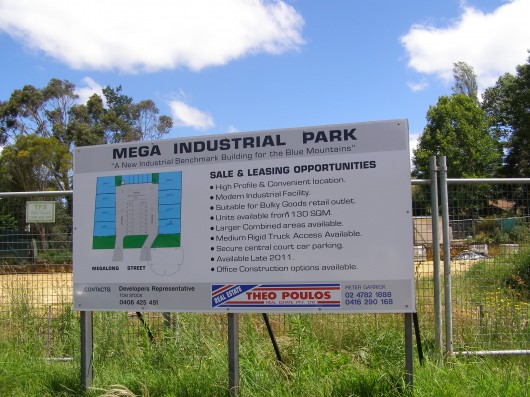 The Theo Poulos promoted ‘Mega Industrial Park’
excavated right behind this rare, significant Eucalyptus oreades,
~ as if the developer or Theo Poulos gives a crap!
(Photo by Habitat Investigator 20120111, free in public domain, click photo to enlarge) The Theo Poulos promoted ‘Mega Industrial Park’
excavated right behind this rare, significant Eucalyptus oreades,
~ as if the developer or Theo Poulos gives a crap!
(Photo by Habitat Investigator 20120111, free in public domain, click photo to enlarge)
.
But then Blue Mountains Council’s so-called Significant Tree Register has always been a crock of deceptive community greenwashing!
As soon as any tree on its register becomes slightly inconvenient, our pro-development Blue Mountains Council, strangled by Liberal-Labor Party vested interests, easily turns a blind eye to significant Blue Mountain heritage and no more significant tree.
Is it any wonder that as the Blue Mountains is allowed to be developed and its natural amenity destroyed that outsiders no longer see the Blue Mountains as a significant attraction, but more as an extension of Sydney sprawl? They just speed past on that forever faster, noisier and more dangerous Trucking Expressway!
.
Tags: Blue Mountains, Blue Mountains City Council, Blue Mountains Council, Blue Mountains Significant Tree Register, Blue Mountains World Heritage Area, endemic, Eucalyptus oreades, industrial development, Lest we forget, Megalong Street, Oreades Forest, significant trees
Posted in Blue Mountains (AU), Threats from Development, Threats from Greenwashing | 1 Comment »
Add this post to Del.icio.us - Digg
Monday, December 26th, 2011
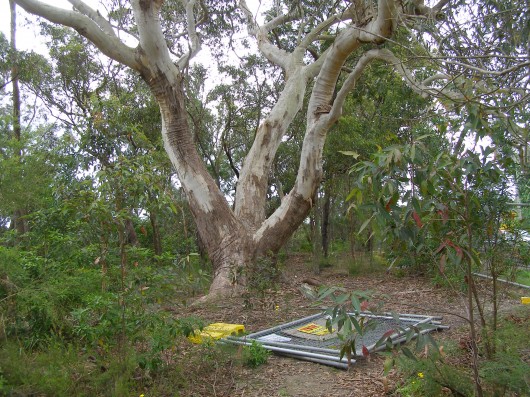 A native Scribbly Gum of Faulconbridge, Blue Mountains, Australia
…perhaps over 200 years old, healthy and in its natural setting.
(Photo by Editor 20111226, free in public domain, click photo to enlarge) A native Scribbly Gum of Faulconbridge, Blue Mountains, Australia
…perhaps over 200 years old, healthy and in its natural setting.
(Photo by Editor 20111226, free in public domain, click photo to enlarge)
.
.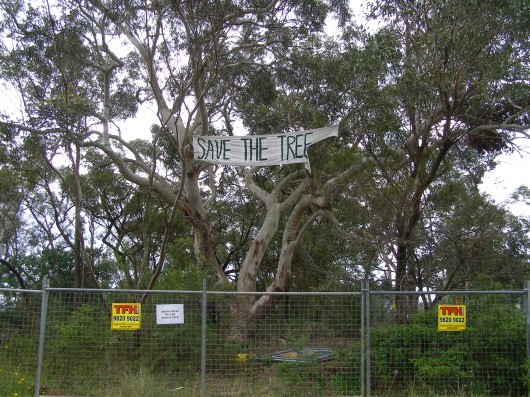 …but simply because land developers want to destroy the bush for selfish housing, they legally claim the tree is ‘potentially dangerous’
It seems the New South Wales Court Commissioner has sympathised and condemned the tree to a chainsaw death.
(Photo by Editor 20111226, free in public domain, click photo to enlarge) …but simply because land developers want to destroy the bush for selfish housing, they legally claim the tree is ‘potentially dangerous’
It seems the New South Wales Court Commissioner has sympathised and condemned the tree to a chainsaw death.
(Photo by Editor 20111226, free in public domain, click photo to enlarge)
.
Court Presumptuous?
.
The New South Wales Land (before) Environment Court has demonised and stigmatised this native Eucalypt tree as a “hybrid” (i.e. as a ‘half cast’ in human terms). The Acting Commissioner has ruled a death warrant upon this native old growth Eucalypt in its natural bushland setting on the following three bases:
..
Basis #1. Blue Mountains ‘Significant Tree’ protection ignores claims of a tree being somehow dangerous (however contrived, false and self-servingly malicious the rationale)
.
“While the provisions of (Blue Mountains Council’s) Development Control Plan (DCP) 9 must be considered as a fundamental element in the decision process…it does not necessarily follow that the tree should be retained under any circumstances.
“DCP 9 is silent on how to address trees that are potentially dangerous or unhealthy although Clause 6 provides the opportunity to “cut down”… any tree on the Register of Significant Trees” but with the consent of Council.”
(Ed: Blue Mountains Council had unanimously rejected the development application – so the ‘acting’ Commissioner is presuming any real opportunity and by raising such weak argument is siding with the developer).
.
Basis #2. The ‘acting’ Commissioner rejects the tree’s scenic quality instantly without due consideration and with a presumed fear of trees
.
“Accepting that the Hybrid adds to the scenic quality of the site and the surrounding area, this benefit needs to be balanced against the likely longevity of the tree and its health. (Ed: The Court has no grounds for estimating the longevity of this tree, and seems to be surmising on the basis of personal prejudice).
In this case, I have little trouble in concluding that the balance falls in favour of the removal of the tree . The conclusions of the two tomograph (xray) tests and the evidence of Dr McDonald and Mr James, and supported by the council officer, leave little doubt as to the appropriate outcome.
(Ed: Tomograph tests and evidence withheld in Court decision, so how do we know the tree is unhealthy?)
“I do not accept that the retention of the tree, irrespective of the scenic quality links to the area, should be preferred when there is a serious and legitimate question over the safety of the tree. (Ed: The “serious and legitimate question over the safety of the tree” is unsubstantiated and appears presumptive).
“In my view, the overwhelming expert and scientific evidence clearly suggests that the tree is dangerous and presents an unsafe situation for future ocupants of the site.”
(Ed: ‘Overwhelming‘ from what independent qualified and scientifically relevant source and where is the report? The ‘acting‘ Commissioner’s presumption of ‘future occupants of the site‘ suggests a high probability of judicial bias).
.
Basis #3. Tree canopies are inconsistent with housing safety
.
“Even if a dwelling is constructed outside of the area covered by the tree canopy, I am not satisfied that (it) sufficiently overcomes the potential danger from the tree. It would be clearly impractical to fence off the area under the canopy, given the limited area remaining for a dwelling on the site and the need to provide ancillary matters such as private open space and building setbacks.” (Ed: The Court is prejudging that the developer proposal for dwellings (x2) and proposed private open space and building setbacks have precedent values over the natural values of pre-existicng native bushland including a Council-protected significant mature native tree, native vegetation and bushrock).
“The suggestion by Ms Hobley that a dwelling could be located underneath the (tree) canopy is misconceived, given the weight of evidence for branch failure and which is supported by the obvious example where an existing branch has failed and only remains because it is held up by another tree on the site. I am not satisfied that Ms Hobley has given proper consideration to the potential for injury in her assessment of the tree.”
.
(Ed: The ‘acting’ Commissioner conveys an preconceived view that trees are dangerous. Details of “an existing branch” failing are not available in the Court’s decision.)
.
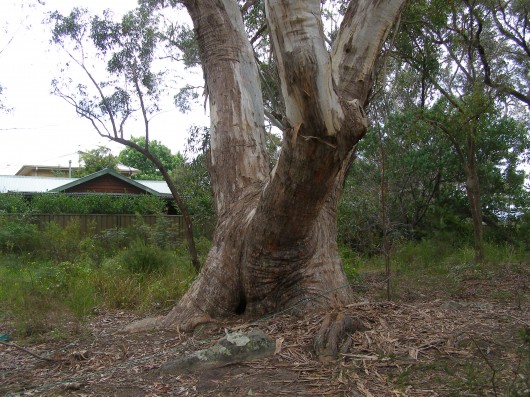 A native Eucalypt, condemned as a ‘hybrid’
by those who themselves are but hybrid descendants of colonists
because human invasion is enshrined in law as having a superior value than existing native old growth.
(Photo by Editor 20111226, free in public domain, click photo to enlarge) A native Eucalypt, condemned as a ‘hybrid’
by those who themselves are but hybrid descendants of colonists
because human invasion is enshrined in law as having a superior value than existing native old growth.
(Photo by Editor 20111226, free in public domain, click photo to enlarge)
.
The Habitat Advocate is pleased to support the efforts of local people in Faulconbridge trying to save this grand native tree from being killed. For further information visit: ^http://savethetree.org/
.
.
‘Native Cleansing’
.
Clearing native trees for human development is a value judgment of convenience. Philosophically native tree cleansing is no different to ethic cleansing of one human ethic group of another.
 Native forest deforestation (ethnic cleansing)
– at record levels across New South Wales Native forest deforestation (ethnic cleansing)
– at record levels across New South Wales
.
‘Ethnic Cleansing’ is a process in which advancing army of one ethnic group expels civilians of other ethnic groups from towns and villages it conquers in order to create ethnically pure enclaves for members of their ethnic group.
‘Serbian military commander in Bosnia, a war criminal sought by the War Crimes Tribunal in The Hague, Ratko Mladic, sometimes issued specific orders to his subordinates to shell a particular village more than others, because there is less Serbs and more Muslims living there. Often, refugees of one ethnic group previously “cleansed” from their homes by other ethnic group are made to live in freshly “cleansed” territory of that other ethnic group.’
.
[Source: ^http://balkansnet.org/ethnicl.html]
.
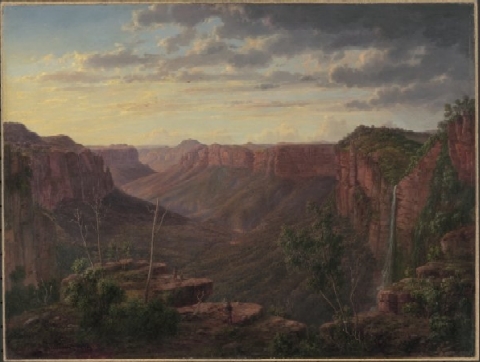 In 2011 humanity continues to trash the sublime for a selfish vista In 2011 humanity continues to trash the sublime for a selfish vista
.
http://www.youtube.com/watch?v=AbaIgHFcEaU&feature=player_detailpage
.
.
Further Reading:
.
[1] ^http://treeshaverightstoo.com/
‘It’s not just humans who have rights, all beings do. The right not to be polluted is a right that belongs to us as well as to the Earth, to the air we breathe and to future generations. There are other rights which apply to us all, the problem is that they are not yet recognised internationally. But this is rapidly changing and you can find more information about the campaigns and progress of this fast developing arena of humanitarian and environmental law, called Earth Law.’
.
[3] ‘Should Trees Have Standing? – Toward Legal Rights for Natural Objects’, by Christopher Stone, ^http://isites.harvard.edu/fs/docs/icb.topic498371.files/Stone.Trees_Standing.pdf [Read Article]
.
[2] ^http://therightsfuture.com/t16-do-trees-have-rights/
.
[3] ^http://northshorewoman.blogspot.com/2011/12/trees-have-rights-too.html
.
Tags: Blue Mountains, Blue Mountains Council, Development Control Plan, Earth Law, ethnic cleansing, Faulconbridge, Land and Environment Court, native cleansing, save the tree, Scribbly Gum, significant trees, species justice
Posted in Blue Mountains (AU), Ph04 Species Justice, Threats from Development, Threats from Weak Environmental Laws | No Comments »
Add this post to Del.icio.us - Digg
Wednesday, December 21st, 2011
There is a ‘baby boomer‘ political penchant to encourage more and more freight to travel by truck, which has dominated Australian Government transport planning for the past sixty years since World War II.
It is a short-term tactical stop-gap measure. Compared with rail freight, road linehaul for large volumes, over long distances, in the long term is price uncompetitive, and Peak Oil driving up fuel costs will eventually prove road linehaul a strategic economic blunder.
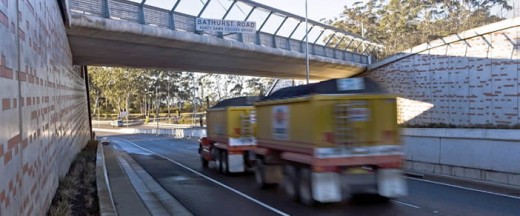 Speeding B-doubles increasingly dominate the highway over the Blue Mountains
‘Woe betide anyone who gets in my way!‘
(Photo by Editor, free in public domain) Speeding B-doubles increasingly dominate the highway over the Blue Mountains
‘Woe betide anyone who gets in my way!‘
(Photo by Editor, free in public domain)
.
Yet ‘road-centric’ freight policy dominates the infrastructure planning, simply because it is being driven by the self-centred vested interests of the trucking industry – influenced (read ‘bought‘) by ongoing substantial monetary donations (read ‘bribes’) to the electoral campaigns of alternating Labor and Liberal governments. Visit ^http://democracy4sale.org/ and choose either:
.
Money talks, hence the political penchant to favour road freight. Whereas rail, entrenched as a government monopoly, has long denied any community say. Rail has become the Cinderella to Road where only a small honourary volunteer lobby, the Australasian Railway Association (ARA) has not the funds to compete against the collective corporate might of trucking donors. Read about the ARA: ^http://www.ara.net.au/site/index.php
The Liberal-Labor Party’s Auslink National Transport Plan since 2004 professed ‘a new strategic framework for the planning and funding of Australia’s roads and railways to meet long term economic and social needs.’ However, in reality the funding has all but gone into building bigger and more highways.
News is, we are about to enter the year 2012, so we should have advanced somewhat from post-war trucking thinking.
Yet in the Blue Mountains, west of Sydney, well over $1 billion is forecast to be spent to build a massive highway viaduct and tunnel; simply so that larger and faster trucks can cart freight, fuel and ore over the Blue Mountains and to bypass the village of Mount Victoria. The fact that a rail line following a similar route exists and has long been used to cart copious quantities of coal over the Blue Mountains, is ignored by a truck-centric political mindset. The planned Mount Victoria bypass is just one of the multiple ongoing highway widening sections being constructed by Roads and Traffic Authority (RTA) contractors over the Blue Mountains and ultimately extending from Penrith in Sydney’s outer metropolitan west to the New South Wales central-west regional town of Orange, 250km away.
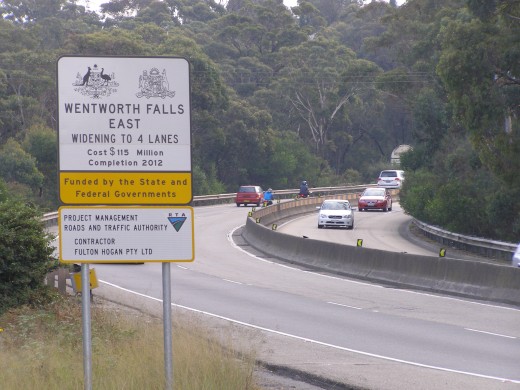 Great Western Highway, Wentworth Falls, March 2010
This trucking section just $115,000,000 (pre-blowout estimate)
(Photo by Editor, free in public domain)
Great Western Highway, Wentworth Falls, March 2010
This trucking section just $115,000,000 (pre-blowout estimate)
(Photo by Editor, free in public domain)
.
The widening of the highway has caused the destruction of much native vegetation and has ruined the bushland amenity of the villages and towns of the Central Blue Mountains. Construction has caused irreversible sediment contamination of many Blue Mountains waterways that drain from the highway ridgeline downstream into the Blue Mountains National Park and World Heritage Area.
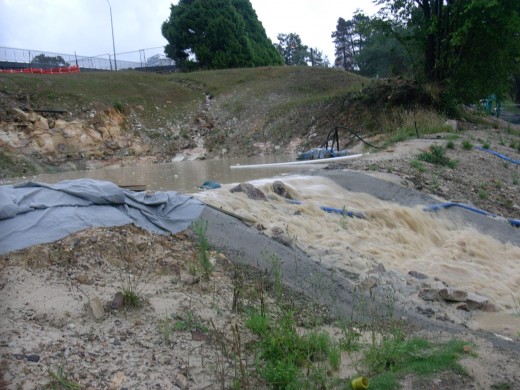 Leura, January 2006
– collateral stormwater pollution of downstream creeks to serve the Trucking Expressway
(Photo by Editor, free in public domain, click photo to enlarge) Leura, January 2006
– collateral stormwater pollution of downstream creeks to serve the Trucking Expressway
(Photo by Editor, free in public domain, click photo to enlarge)
.
Since 1996, the widening of the Great Western Highway over the Blue Mountains has cost over a billion dollars already. Yet the highway runs parallel to an existing dual rail line, which for the most part runs right alongside one another. One justification argued for the massive cost and widening of the highway is to relieve traffic congestion for motorists, but there is a low population base in the Blue Mountains as settlement is confined to the ridgeline over the Blue Mountains where the highway and rail run together. Steep terrain either side prevent a large population expansion.
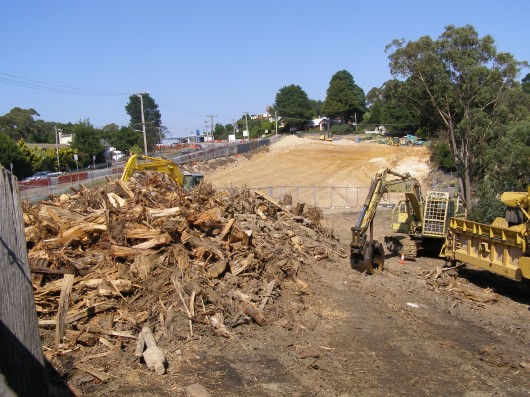 Katoomba, May 2009
– collateral vegetation damage to serve the Trucking Expressway
(Photo by Editor, free in public domain, click photo to enlarge) Katoomba, May 2009
– collateral vegetation damage to serve the Trucking Expressway
(Photo by Editor, free in public domain, click photo to enlarge)
.
Before construction began, the only systemic traffic congestion on the highway was at weekends when tourists from Sydney ventured west in their cars. Spending billions to encourage domestic regional tourism has not been the real justification. The real justification has been and continues to be to encourage more truck freight along the Great Western Highway.
Yet the public is still waiting for a cost-benefit analysis, a calculation of any return on investment, an end-to-end journey analysis of the freight options, an holistic comparison to rail.
Instead, not only has there been a road-only freight focus, the trucks have got bigger. Governments are now permitting and encouraging the use of 19 metre ‘B-doubles’ along the highway. It is only a matter of time before 26 metre B-doubles turn up. In Victoria they are permitting B-triples – basically road-trains! Successive Labor and Liberal governments at both national and state level have maintained a truck-centric mindset since the 1980s when the NSW Greiner Government abandoned and close down much of the State’s rail infrastructure, including the closure of rail depots at Valley Heights and Junee.
This baby boomer political penchant has been encouraged and lauded by baby boomer himself, Bob Debus, long-time Labor politician for the NSW seat of Blue Mountains then the Federal seat of Macquarie, both covering the Blue Mountains region. Bob Debus has since retired, yet the Labor boomer mindset perpetuates with its truck-centric fervour.
.
“It is with dismay that I watch the Mountains stand by as the RTA fulfills Bob Debus’ promise of an “upgraded” highway (read Trucking Expressway) – by his own admission – built to carry 26m B-double trucks. The RTA admits that when the western container hubs are finished they will generate 4000 extra B-double movements per day. Parked end to end they would stretch 102 km – every day! Goondiwindi, Toowoomba and many other towns don’t allow them but we will see them roaring through every Mountains town – past schools, shops and homes.”
.
~ Dennis Plink, Hartley Vale (letter ‘B-double agenda‘ in Blue Mountains Gazette, 20090304, p.8.
.
The widening of the highway into a trucking expressway is wrecking the Blue Mountains. And certainly, those trucks have increased – in number, in size and length and in speed. These bigger, faster trucks are not policed. They are turning the Great Western Highway into a dangerous death zone.
 Speeding B-Double truck overturns on Lapstone Hill
– at an already widened section of the Trucking Expressway
Zoom, zoom, zoom!
(Photo by Top Notch Video). Speeding B-Double truck overturns on Lapstone Hill
– at an already widened section of the Trucking Expressway
Zoom, zoom, zoom!
(Photo by Top Notch Video).
Last July, on the highway at Lawson near Queens Road, truck driven by a 66-year-old Murrangaroo man collided head-on with an eastbound car trapped a female passenger, followed by a separate collision between a truck and a car near Boland Ave at Springwood. On Friday, 29th July 2011 on Lapstone Hill the driver of a semi-trailer failed to negotiate a left-hand bend while travelling east and crashed into the concrete median barrier. The impact caused the truck’s trailer — containing a full load of bark — to tip over the barrier and slide a short distance into the path of a westbound Mitsubishi Lancer, driven by a 30-year-old Hazelbrook woman, who remained trapped before being rushed to Westmead Hospital. Traffic chaos ensued as all westbound lanes were closed for more than eight hours and one eastbound lane also shut for the clean-up operation. Lapstone Hill is one of the widened sections of the highway.
.
[Source: ‘Blue Mountains highway mayhem’, by Shane Desiatnik, Blue Mountains Gazette, 20110803, ^http://www.bluemountainsgazette.com.au/news/local/news/general/blue-mountains-highway-mayhem/2246694.aspx?storypage=0]
.
Increasingly we are reading in local newspapers of road trauma involving trucks. Across Australia, during the 12 months to the end of March 2009, 248 people died from 229 crashes involving heavy trucks or buses. These included:
- 138 deaths from 124 crashes involving articulated trucks (semi-trailers, B-doubles, B-triples)
- 90 deaths from 86 crashes involving heavy rigid trucks
- 22 deaths from 21 crashes involving buses.
.
[Source: ‘Fatal Heavy Vehicle Crashes Australia: Quarterly Bulletin, January-March 2009’, Summary, ^http://www.infrastructure.gov.au/roads/safety/publications/2009/fhvca_q12009.asp]
.
.
Here are just some of the tragic road trauma incidents involving trucks across Australia over the past year:
.
‘Truck burns at Yelgun’ … two days ago!
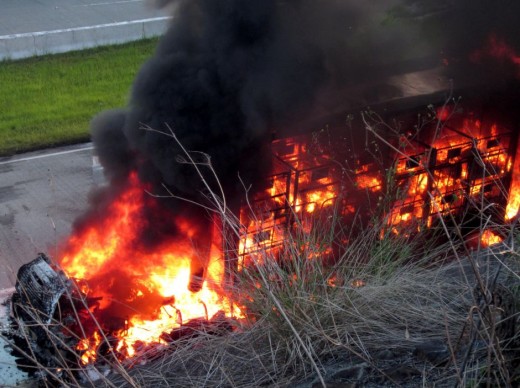 . .
Flames engulf a postal truck at Yelgun on the NSW north coast on December 18, 2011. The driver stopped the truck after noticing smoke pouring from the engine bay. He collected his belongings and departed the vehicle before the flames took hold.
.
[Source: ‘Truck burns at Yelgun”, by Kalindi Starick, ABC, 20111220, ^http://www.abc.net.au/news/2011-12-19/flames-engulf-a-postal-truck-at-yelgun-on-the-nsw-north-coast/3737752]
.
‘Teenage driver killed in truck collision’…two days ago
.
One woman was killed and five people were injured in two accidents involving B-double trucks.
- Engineers were called to the scene of a dramatic accident on the Gateway Motorway at Boondall in Brisbane about midday yesterday, when a B-double truckexploded after it and a car collided.
- On the Bruce Highway near Rockhampton, a 19-year-old woman died and four people were injured when a car and a B-double truck collided. Police said the station wagon tried to turn into the southbound lanes of theBruce Highway at Marmor just before 8pm on Friday when the car and truck, whichwas travelling in the northbound lane, collided. The 19-year-old driver was killed, while her three female passengers, two aged19 and one aged 18, were taken to Rockhampton hospital. The three are in a stable condition. The 65-year-old driver of the B-double was taken to hospital for precautionary treatment and has been released.
.
[Source: ‘Teenage driver killed in truck collision’, by Date: December 18 2011, Ellen Lutton, 20111218, Sydney Morning Herald, ^http://www.smh.com.au/queensland/teenage-driver-killed-in-truck-collision-20111217-1p0ax.html?skin=text-only]
.
‘Truck crash closes Melbourne freeway’
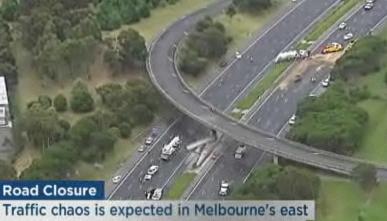 Melbourne’s Monash Freeway is closed in both directions after a semi-trailer crashed into a bridge pylon in the suburb of Mulgrave in the city’s south-east. Melbourne’s Monash Freeway is closed in both directions after a semi-trailer crashed into a bridge pylon in the suburb of Mulgrave in the city’s south-east.
.
[Source: ‘Truck crash closes Melbourne freeway’, ABC, 20111213, ^http://www.abc.net.au/news/2011-12-13/truck-crash-closes-melbourne-freeway/3727918]
.
‘Truckie quizzed over fatal crash’
Two people have died in a crash on the Pacific Highway near Yamba on the NewSouth Wales north coast.
A 62-year-old man and a 51-year-old woman from the Leeton area died when two cars collided about 11:00am (AEDT) today. A woman and three children who were in the other car have been taken to the Coffs Harbour Hospital. Police say a truck driver who was involved in the accident but failed to stop, was later pulled over at Ballina. Police are interviewing him. Rebecca Walsh, from the Traffic Management Centre, says the Pacific Highway is closed in both directions and vehicles are being diverted along the Summerland Way at Grafton.
.
[Source: ‘Truckie quizzed over fatal crash’, ABC, 20111111, ^http://www.abc.net.au/news/2011-11-11/truckie-quizzed-over-fatal-crash/3660874]
.
‘Chemical alert after truck rolls in Blue Mountains’
.
Fire crews are battling to contain a major chemical spill on the Great Western Highway at Katoomba in the Blue Mountains, after a truck overturned and 20,000 litres of a bright green industrial chemical poured out.
Protective bunds have been built around the spill site to stop the chemical, which is possibly a type of hydraulic fluid, reaching the iconic Leura cascades. The chemical is described as biodegradable, but it can be a toxic irritant to skins and eyes if touched.
Six fire crews were at the site at 5pm, plus a hazardous materials unit from St Marys, a spokesman for Fire and Rescue NSW said.National Parks rangers, Blue Mountains council staff and fire crews are monitoring the extent of the spilled fluid, some of which entered the drainage system. Council staff have poured gravel around the edge of the spill area to try and contain it. The truck rolled over at about 2pm, and the driver’s condition is unknown, although he or she was understood to not have been trapped in the vehicle.
.[Source: ‘Chemical alert after truck rolls in Blue Mountains’, by Ben Cubby, Environment Editor, 20111026, Sydney Morning Herald, ^http://www.theleader.com.au/news/national/national/environment/chemical-alert-after-truck-rolls-in-blue-mountains/2337200.aspx]
.
Editor: Subsequent reports by a Katoomba resident reported observing the green hydraulic fluid flow in quantities down Govetts Creek. The contaminant would probably have ended up in the World Heritage Area of the creek within the Grose Valley, but would the RTA, Blue Mountains Council or the National Parks Service care?
‘.
‘Truck overturns at Tabbimoble’ (Maclean)
.
A woman suffered minor injuries when the truck she was driving overturned on the Pacific Highway at Tabbimoble yesterday morning.
The B-double truck carrying general freight was heading north on the Pacific Highway and was about 2km south of the New Italy complex and 25km north of Maclean when it rolled shortly before 5am. The 46-year-old woman who was at the wheel of the Volvo semi-trailer complained of back pains and was taken by ambulance to Lismore Base Hospital. The highway was partially blocked for four hours while emergency service cleared away the debris. The accident occurred on what has become a notoriously black stretch of road where several fatalities have occurred in recent years.
.
[Source: ‘Truck overturns at Tabbimoble’, Northern Star, 20110609, ^ http://www.northernstar.com.au/story/2011/06/09/truck-overturns-tabbimoble/]
.
‘Cyclists mowed down by truck’
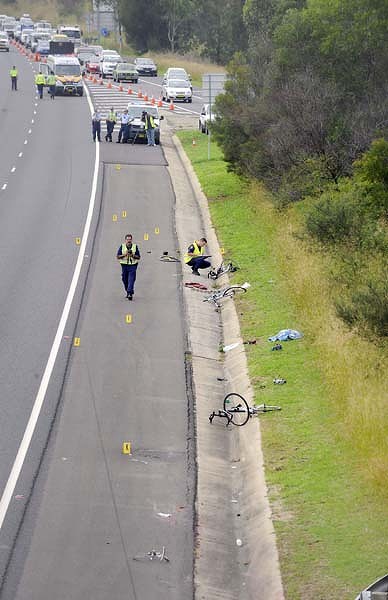 M4 Motorway (aka Trucking Expressway) on approach to the Blue Mountains
Photo: Adam Hollingworth M4 Motorway (aka Trucking Expressway) on approach to the Blue Mountains
Photo: Adam Hollingworth
.
One man has died after a truck veered into a group of cyclists on the M4 motorway.
Fatigue may have caused a truck driver to veer into the breakdown lane and mow down a group of cyclists, killing one, on the M4 in Sydney’s west. Police said a group of four cyclists were riding in the breakdown lane of the M4 near the Northern Road overpass at South Penrith when they were struck by a B-double truck about 7.40am today. A male cyclist died and the three others sustained serious injuries. The injured were taken to Nepean Hospital.
A WorkCover spokesman said a preliminary investigation was under way to ascertain whether driver fatigue caused the accident. Police said the male truck driver was taken to hospital for mandatory blood and urine tests. Police are investigating the cause of the crash.
.
[Source: ‘Cyclists mowed down by truck’, Sydney Morning Herald sourcing AAP , 20100410, ^ http://www.smh.com.au/nsw/cyclists-mowed-down-by-truck-20100410-rz7v.html]
.
‘Overtaking gamble cost highway driver his life, police believe’
.
One person has died after a truck carrying chemicals exploded after colliding with a car on the NSW north coast this morning.
Police believe a car driver’s early morning gamble in trying to pass a B-double truck on a no-overtaking stretch of the Pacific Highway cost him his life. The sedan was travelling southbound at Warrell Creek just before 4am when it appeared to pull out into the oncoming lane to overtake the truck. It then crashed head-on into a second, northbound, B-double carrying chemicals, Senior Constable Brian Carney of the Mid North Coast Crash Investigation Units aid.
.
[Source: ‘Overtaking gamble cost highway driver his life, police believe’, by Glenda Kwek, 20110405, ^http://www.smh.com.au/nsw/overtaking-gamble-cost-highway-driver-his-life-police-believe-20110405-1cz01.html]
.
‘Exploded fuel tanker closes Pacific Highway’
The Pacific Highway on the New South Wales north coast will be closed until New Year’s Day while crews clear a fuel tanker that exploded and killed the driver.
The tanker hauling 40,000 litres of fuel overturned and exploded on what is regarded by truckies as a notorious stretch of the highway, near Tintenbar, 10 km north of Ballina.
Authorities have set up a one-kilometre exclusion zone around the burning tankerand more than 100 firefighters equipped with breathing apparatus were sent to the scene.The ambulance service says the truck driver was killed in the blast, while two people have been freed from a nearby car after being trapped when powerlines came down on their vehicle. The second trailer of the B-double was thrown into a paddock where it leaked fuel into a nearby wetland, and police still cannot get to the cabin of the burnt truck where the driver’s body remains inside.
Another tanker driver, Gary, says the driver is one of their own but they do not know who.”It is sad to be holed up on the side of the road like this. And it’s sad for a driver that’s not going to go home to his family,” he said.
The truck was laden with diesel and unleaded fuel, which has now been mostly contained. Police say they will not be able to assess the damaged road until the scorched truck is moved, but they expect the Pacific Highway to be closed for the rest of today. Six other trucks are banked up behind the accident site unable to turn around.
.
[Source: ‘Exploded fuel tanker closes Pacific Highway’, ABC, 20101231, ^ http://www.abc.net.au/news/stories/2010/12/31/3104386.htm?site=goldcoast]
.
‘Truck lobby donations seem more important than people’s lives!‘
.
~ Dennis Plink, loc. cit.
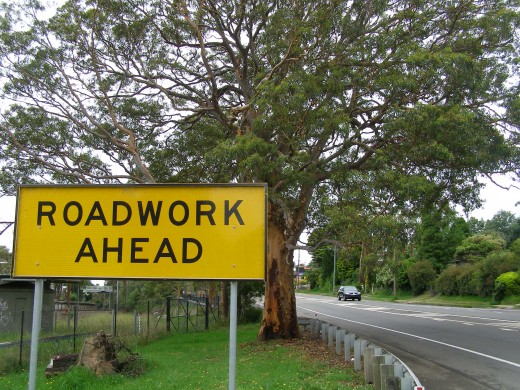 Native Angophora 300 years old.
The RTA’s Environment Manager says it’s in the way – Chip it!
– collateral damage for the Trucking Expressway
…note railway line on left Native Angophora 300 years old.
The RTA’s Environment Manager says it’s in the way – Chip it!
– collateral damage for the Trucking Expressway
…note railway line on left
>:/
.
Tags: ARA, Australasian Railway Association, b-doubles, B-triples, baby boomer, Blue Mountains, Blue Mountains Council, Blue Mountains National Park, Blue Mountains World Heritage Area, Bob Debus, cyclist, dangerous trucks, Eucalyptus oreades, fatal crash, Great Western Highway, Katoomba, Labor, Liberal, Liberal-Labor Party, National Parks Service, political donations, political penchant, residential amenity, Roads and Traffic Authority, RTA, significant trees, truck collision, truck crash, truck lobby donations, truck overturns, truck thinking, trucking expressway, trucking thinking, Yelgun
Posted in Blue Mountains (AU), Threats from Road Making | No Comments »
Add this post to Del.icio.us - Digg
Saturday, March 26th, 2011
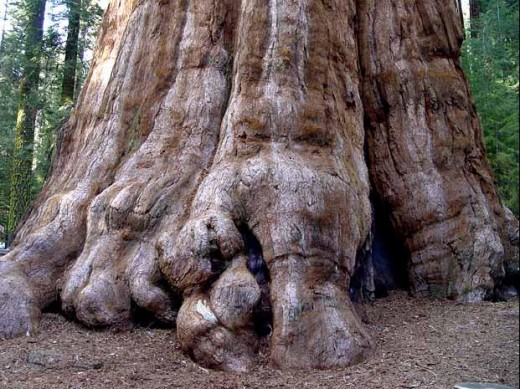 ‘General Sherman’ ~ just another sequoia? (pronounced ‘sequoya’)
Sequoia & Kings Canyon, Sierra Nevada, California, USA
^http://www.nps.gov/seki/historyculture/gfgst.htm ‘General Sherman’ ~ just another sequoia? (pronounced ‘sequoya’)
Sequoia & Kings Canyon, Sierra Nevada, California, USA
^http://www.nps.gov/seki/historyculture/gfgst.htm
.
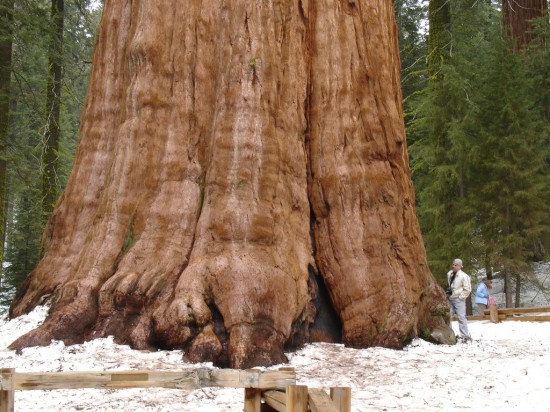 The General Sherman Tree
– the world’s largest tree, is the prime visitor attraction in the Giant Forest.
[Source: ^http://www.nps.gov/seki/historyculture/gfgst.htm]
. The General Sherman Tree
– the world’s largest tree, is the prime visitor attraction in the Giant Forest.
[Source: ^http://www.nps.gov/seki/historyculture/gfgst.htm]
.
“Sequoia sempervirens’ common names include coast redwood, California redwood, and giant redwood. It is an evergreen, long-lived, monoecious tree living 1200–1800 years or more. This species includes the (current) tallest trees on Earth, reaching up to 379 feet (115.52 m) in height and up to 26 feet (7.9 m) diameter at breast height. Before commercial logging and clearing began by the 1850s, this massive tree occurred naturally in an estimated 2.1 million acres along much of coastal California (excluding southern California where rainfall is not abundant enough) and the southwestern corner of coastal Oregon within the United States.” [Source: ^Wikipedia – read more].
.
“The Sierra Nevada is still growing today. The mountains gain height during earthquakes on the east side of the range. But the mountains are being shortened by erosion almost as quickly as they grow. This erosion has deposited sediments thousands of feet thick on the floor of the San Joaquin Valley.”
[Source: ^http://www.nps.gov/seki/historyculture/gfgst.htm]
.
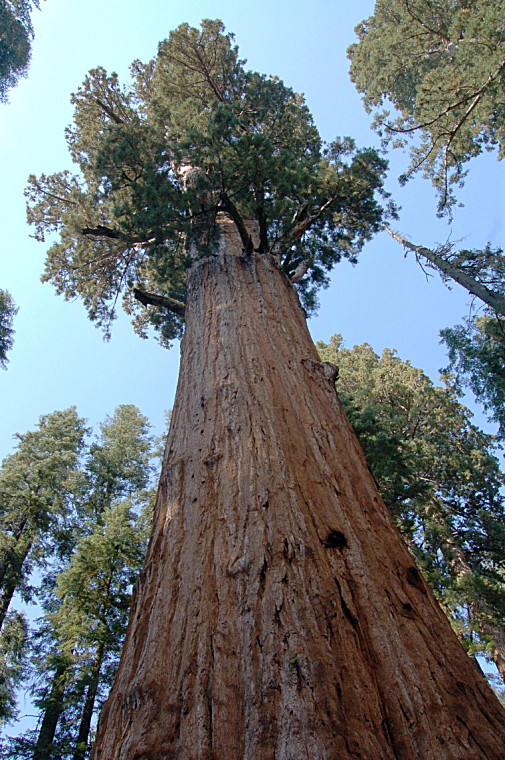
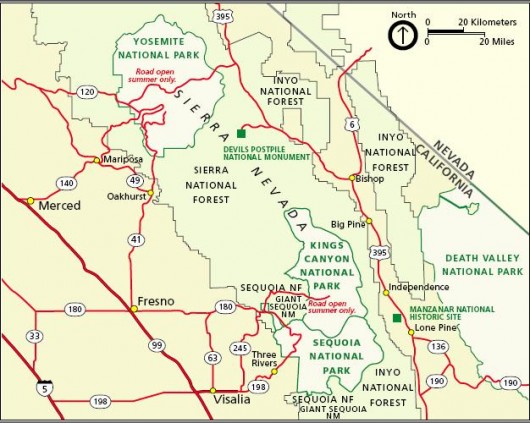
.
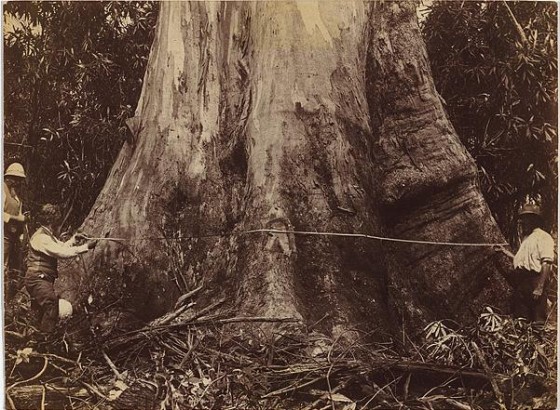 ‘Giant tree’ at Neerim (Gippsland, Victoria, Australia), forty feet girth c.1889
AUSTRALASIAN ART, Photo by Nicholas CAIRE, b.1837 Guernsey, United Kingdom – Australia d.1918[Gelatin silver photograph image 15.0 h x 20.2 w cm, Purchased 1983, Accession No: NGA 83.3083]
.
.
“The men shown here measuring the diameter of a giant eucalypt were not loggers or tree-lovers. They were attempting to determine whether Australian trees were bigger than the famed 400-foot giant redwoods of California. It was mostly national pride surrounding the Australian Centennial of European settlement which motivated scientists and photographers in the 1880s to seek out the remaining giant trees in the more remote areas of Victoria. The Americans claimed that their redwoods were the greatest because of their combined height and girth. In the dense Australian bush, it
was easier to measure the girth than the height and presented a much more dramatic image for a photograph.
.
The general public followed the giant tree debate in the papers and also purchased photographs of them and other idyllic bush scenes. By the late 19th century, the Australian population mostly lived and worked in the cities. They became day-trippers and used the new railway networks to take their recreation in the bush. Nicholas Caire, one of the most active photographers to seek out and record the giant trees, travelled over a number of years on the new rail line to Neerim town reserve.
.
Australia’s giant trees were widely depicted in colonial art as mighty symbols of the pre-settlement and pioneer era. Caire, whilst accepting the desirability of logging and urban development, was also one of those who argued for the preservation of examples for future generations.
.
Most of the awesome giant trees were felled or burnt in his lifetime. Now they are preserved only in photographs.” ‘Giant tree’ at Neerim (Gippsland, Victoria, Australia), forty feet girth c.1889
AUSTRALASIAN ART, Photo by Nicholas CAIRE, b.1837 Guernsey, United Kingdom – Australia d.1918[Gelatin silver photograph image 15.0 h x 20.2 w cm, Purchased 1983, Accession No: NGA 83.3083]
.
.
“The men shown here measuring the diameter of a giant eucalypt were not loggers or tree-lovers. They were attempting to determine whether Australian trees were bigger than the famed 400-foot giant redwoods of California. It was mostly national pride surrounding the Australian Centennial of European settlement which motivated scientists and photographers in the 1880s to seek out the remaining giant trees in the more remote areas of Victoria. The Americans claimed that their redwoods were the greatest because of their combined height and girth. In the dense Australian bush, it
was easier to measure the girth than the height and presented a much more dramatic image for a photograph.
.
The general public followed the giant tree debate in the papers and also purchased photographs of them and other idyllic bush scenes. By the late 19th century, the Australian population mostly lived and worked in the cities. They became day-trippers and used the new railway networks to take their recreation in the bush. Nicholas Caire, one of the most active photographers to seek out and record the giant trees, travelled over a number of years on the new rail line to Neerim town reserve.
.
Australia’s giant trees were widely depicted in colonial art as mighty symbols of the pre-settlement and pioneer era. Caire, whilst accepting the desirability of logging and urban development, was also one of those who argued for the preservation of examples for future generations.
.
Most of the awesome giant trees were felled or burnt in his lifetime. Now they are preserved only in photographs.”
~Anne O’Hehir
.
Indeed…
“The largest tree on Planet Earth is not the California Redwood, but the Mountain Ash (Eucalyptus regnans). The largest trees ever recorded were located in southern Australia near present day Melbourne. The world’s largest tree was the Ferguson Tree at over 500 feet (154m). It was measured by Surveyor Ferguson in 1872 in the Watts River Catchment near Healesville.”
Read More: Click: http://www.baddevelopers.green.net.au/Docs/talltrees.htm
.
Source: Text © National Gallery of Australia, Canberra 2010, Anne Gray (ed), Australian art in the National Gallery of Australia, National Gallery of Australia, Canberra, 2002, http://cs.nga.gov.au/Detail-LRG.cfm?IRN=106546&View=LRG
.
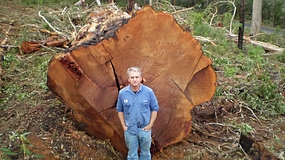
.
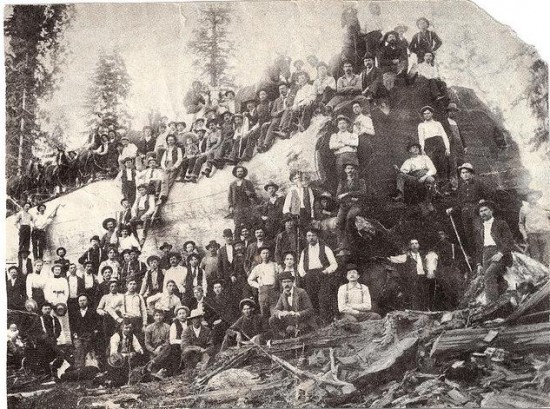 People and Horses on a Gigantic Redwood Log; about 1900.
“This photo is open for down loading for anyone wishing a free copy. Unknown Photo History. I’m fairly certain the tree was a Coast Redwood (Sequoia semperviren) or a Giant Sequoia (Sequoiadendron giganteum) from Central to Northern California or Oregon. I wish this one was still standing. The bark has already been stripped off of it.” [Source: Photo of old photo by David Foster, http://www.flickr.com/photos/21734563@N04/2225069096/] People and Horses on a Gigantic Redwood Log; about 1900.
“This photo is open for down loading for anyone wishing a free copy. Unknown Photo History. I’m fairly certain the tree was a Coast Redwood (Sequoia semperviren) or a Giant Sequoia (Sequoiadendron giganteum) from Central to Northern California or Oregon. I wish this one was still standing. The bark has already been stripped off of it.” [Source: Photo of old photo by David Foster, http://www.flickr.com/photos/21734563@N04/2225069096/]
.
.
Editor’s Comment:
I empathise with David Foster. – ‘I wish this one was still standing‘. Every face in this 1900 photo conveys cultural achievement and exploitative pride.
Now in 2011, has human attitude and on-ground impact toward ‘Old Growth’ really changed any?
Consider ‘Merbau’ timber, readily available from local timber yards across Australia and in New Zealand as ‘Kwila’ (Botanical names: Intsia bijuga and Intsia palembanica). Comparable old-growth rainforest hardwoods include Narra, Yakal, and Ipil. These old growth giants continually to be currently logged illegally deep in rain forests of the Philippines, Solomon Islands, Fiji and Papua New Guinea. Australian and New Zealand households profit from SE Asian rain forest destruction.
The lost natural assets of giant trees, of old growth have diminished the Earth, and have diminished the value of humanity, and of humanity’s value to the Earth. To forest habitat we are but marauders and rapists.
Humanity has become ‘Earth’s Pathogen’.
.
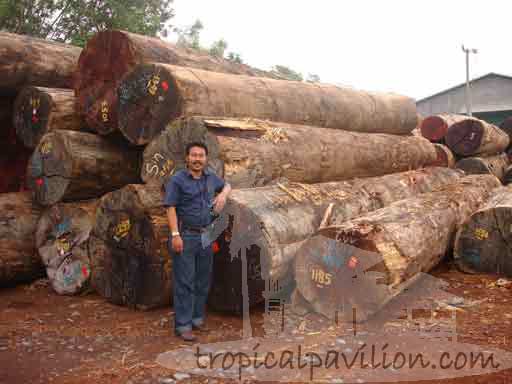 . .
 SE Asia old growth Rainforest Kwila is marketed in Australia and New Zealand as ‘Merbau’
for use mainly in flooring and decking,because of its relative hardness (high Janka rating) and long term stability. SE Asia old growth Rainforest Kwila is marketed in Australia and New Zealand as ‘Merbau’
for use mainly in flooring and decking,because of its relative hardness (high Janka rating) and long term stability.
.
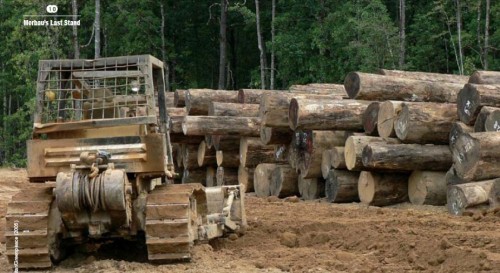
.
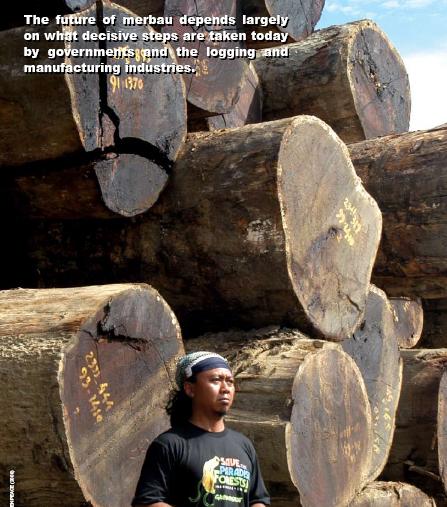
.
.
Rimbunan Hijau Group of Companies
.
“Malaysia’s largest timber group is Rimbunan Hijau (“Forever Green”) (Forbes, 1995). It has timber concessions in Sarawak of around 800,000 hectares (FT,1994), dominates Papua New Guinea’s forestry sector and has forestry interests in New Zealand and China, as well as diversifying into other activities such as the ownership of newspapers in Malaysia and Papua New Guinea (AsiaMoney, 1995). Rimbunan Hijau also owns a 40% share in Limgang Trading Sdn., which has a 310,000 hectares concession in Sarawak (55% of Limbang is owned by Sarawak’s Minister for the Environment and Tourism, James Wong Kim Min) It is privately owned and controlled by one family, headed by Tiong Hiew King. The family are estimated to be worth about US$2.5 billion (Forbes, 1995).”
“Whilst it remains largely a private group of companies, whose operations are veiled in secrecy, the Tiong family has sought to obtain a more public face through the reverse take-over of Berjaya Textiles Bhd (now renamed Jaya Tiasa Holdings Bhd), giving it a listing on the Kuala Lumpur Stock Exchange (FT 1994). Its overseas logging operations appear to remain under the control of the private parts of the group and in Papua New Guinea it is the dominant player through control of a number of associate and subsidiary companies. There are recent rumours that Rimbunan Hijau group owns, or is in the process of acquiring, Primegroup Holdings, a British Virgin Islands registered company with logging interests in Guyana and Papua New Guinea. If this is true, then Rimbunan Hijau group’s international logging interests are, or will shortly become, even more extensive, both geographically and in terms of size. Apart from its logging activities, the company has interests in banking, newspapers and oil-palm plantations. One of Hiew King’s younger brothers is a member of the Malaysian Parliament. Despite the company’s political connections, it has been caught for tax evasion, the Asian Wall Street Journal reported.”
.
[Source: Greenpeace, 1997, http://archive.greenpeace.org/comms/97/forest/asian_companies_malaysia.html, accessed 20110325].
.
“Rimbunan Hijau is a Malaysian based global forest logger and controls around 60% of the forest industry in Papua New Guinea. Rimbunan Hijau is Logging vast areas of virgin PNG forest against national opinion and local customs which infringes on the traditional rights of indigenous resource owners.
- (It is) accused in PNG Government reports of gross human rights abuses, labor abuses, sexual abuses and illegal logging.
- Causing destruction of ancient natural forest and associated systems.
- Conducting broad scale industrial logging operations that infringe on the rights of local people to establish and exploit alternative economic opportunies.
- Is influencing political and other processes to gain and maintain a near monopoly on PNGs forest resources and avoid adequate scrutiny and monitoring of its operations.
- Rimbunan Hijau uses the media to promote its operations to the PNG public – Rimbunan Hijau already OWNS The National newspaper and LEGAL THREATS against their only competitor, the Post Courier, have left it wary of criticising Rimbunan Hijau. These have been the only two print media outlets since The Independent was closed down.”
.
[Source: http://www.forestnetwork.net/rhw/]
.
Rimbunan Hijau is ultimately 50% owned by the Boral “Group” of Australia and 50% by Caltex.
[Source: http://www.scribd.com/doc/24211537/2258-Christchurch-New]
.
…so when Australians and New Zealanders buy Merbau timber from local timber yards, hardward stores and furniture retailers – they are driving South East Asian old growth rainforest deforestation.
.
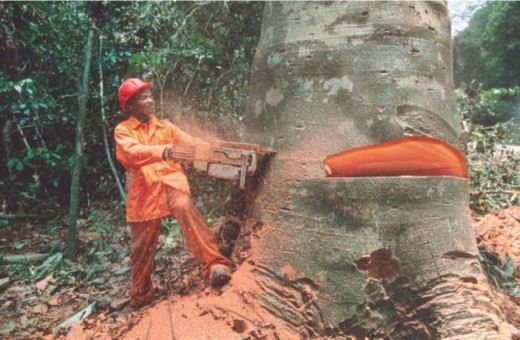
.
.
(The following article from The Guardian in February 2011 is by forests officer for WWF Indonesia, Jimmy Bond, based in West Kalimantan on the island of Borneo)
.
Complacency over deforestation pushes orang-utan closer to extinction
.
“Illegal logging and hunting continues despite legal protection, so the WWF is raising awareness to help save the orang-utan.
The destruction of the world’s rainforests continues at an alarming rate. Where I’m from in Borneo, illegal logging, coupled with hunting, is driving species such as the orang-utan ever closer towards extinction.
 Borneo male orang-utan Wandoo.
There are fewer than 2,000 wild orangutans left in the West Kalimantan province, Indonesia.
©Photograph: Attila Balazs/epa/Corbis Borneo male orang-utan Wandoo.
There are fewer than 2,000 wild orangutans left in the West Kalimantan province, Indonesia.
©Photograph: Attila Balazs/epa/Corbis
.
There are three subspecies of orangutan in Borneo and we only have about 2,000 orangutans left in the wild in West Kalimantan province, and through deforestation and hunting their numbers continue to fall. Just last month I heard from villagers that some people are still killing and eating them even though they’re supposed to be protected by law.
I’ve just been travelling around the region in this part of Indonesia as I’ve been running a series of summer schools as part of a WWF awareness campaign to highlight the problems facing the orang-utan.

Over the past two years, the main focus for the campaign has been children because we’ve found it very difficult to change the minds and attitudes of older generations. We invite the kids to come along to these camps from nearby villages and at the last one more than 200 kids turned up. We do many different activities from drawing to tug-of-war competitions but the over-arching aim is to touch their hearts with stories about this wonderful creature and the rainforests in which they live. We want to leave them with the understanding that these unique creatures need protecting.
We’re also starting to join forces with local government officials and religious leaders to spread the message to communities that live in traditional longhouses. We tell them about a recent success story that acts as a warning against killing orang-utans. One trader in Pontianak, where I’m based, was recently jailed for two years for trading orang-utans.
Such discussion also helps us talk about their habitats and the need to protect them too. In West Kalimantan from 1995, large-scale illegal logging cut through a forest corridor that linked two national parks where one of three subspecies of orang-utan (Pongo pygmaeus pygmaeus) lives. This meant they couldn’t migrate between the two areas and their numbers dropped significantly. This was made worse because the illegal loggers who came here to work also hunted meat from the forests and the orang-utans were in the firing line.
Over the past few years we’ve been trying to highlight these problems to the international media because some of the illegally logged timber was transported over the border to Malaysia where it is made into wood products that are shipped all over the world. Globally, we want people to become educated about where the timber that makes their furniture comes from and the harm it is doing to species and communities. When the forest disappears people no longer have access to food and medicines plus we have also seen more flooding as a result of deforestation. The international media focus also helps push our government to react because not so long ago they were doing nothing to help.
Recently, we’ve seen companies get permits from the government to develop palm oil plantations. But what’s worse is that the permits are just a smokescreen for the companies to get at the timber and leave without planting any palm oil.
So we’re working to make indigenous communities aware of this practice and the best way to do this is by bringing in others who have seen this happen on their land to warn them. If they are forewarned then they know not to allow it to happen to their own communities. These people need to have the forest in good condition because it’s not only home to different species, it’s also where they earn their livelihood.
Looking to the future, my big ambition is to set up an orang-utan rehabilitation centre here in West Kalimantan for subspecies Pongo pygmaeus pygmaeus. At the moment, orphaned babies are taken to other parts of the country where they are kept with the two other subspecies. I want them to be able to breed with their own kind otherwise they could die out. And I fear that if the orangutan disappears, the rainforest won’t last much longer either.”
[Source: The Guardian newspaper (UK) , http://www.guardian.co.uk/environment/blog/2011/feb/03/indonesia-deforestation-orangutan-extinction, accessed Feb 2011]
.
.
Further Reading
.
http://www.nps.gov/seki/historyculture/gfgst.htm
http://en.wikipedia.org/wiki/Intsia_bijuga
http://www.indonesianrainforest.org/irf-news/373-campaign-against-kwila-imports-continues-.html
http://rainforest-action.blogspot.com/2010/09/end-sales-of-kwila-timber-products.html
http://www.greenpeace.org/new-zealand/en/press/illegal-kwila-timber-imports-f/
http://www.info-ri.com/indonesia/rainforest-action-end-sales-of-kwila-timber-products/
http://www.robcousens.com.au/files/D512143129.pdf
http://www.dansson.com/kwila.htm
http://www.greenpeace.org/international/Global/international/planet-2/report/2008/7/merbau-report-2.pdf
Greenpeace, 1997, http://archive.greenpeace.org/comms/97/forest/asian_companies_malaysia.html
http://www.coolearth.org/306/whats-new-32/news-155/illegal-logging-threatening-malaysian-wildlife-453.html
http://www.wwf.org.my/media_and_information/wwf_position_statements/?5741
http://www.ewp.asn.au/certification/certificationcoc.html
http://www.forestnetwork.net/rhw/
http://www.atif.asn.au/
http://www.scribd.com/doc/24211537/2258-Christchurch-New
http://www.baddevelopers.green.net.au/Docs/talltrees.htm
The Guardian newspaper (UK) , http://www.guardian.co.uk/environment/blog/2011/feb/03/indonesia-deforestation-orangutan-extinction
.
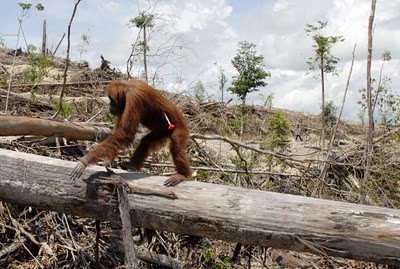 . .
Tags: Boral Group, Californian redwood, Caltex, commercial logging, deforestation, Earth's Pathogen, Eucalyptus regnans, Ferguson Tree, General Sherman Sequoia, Giant Forest, giant redwood, Guam, hallowed majesty, human pathogen, illegal logging, Intsia bijuga, Janka rating, Kalimantan, Kwila, Merbau, merbau flooring, Merbau's last stand, Narra, Neerim, old growth conservation, old growth forest, orang-utan, orang-utan extinction, Oregon, Primegroup Holdings, Rainforest Kwila, Rimbunan Hijau, San Joaquin Valley, Sarawak, Sequoia sempervirens, Sequoiadendron giganteum, Sierra Nevada, significant trees, world's largets tree, Yakal
Posted in 31 Old Growth Conservation!, Congo (CD), Kalimantan (ID), Sumatra (ID), Threats from Deforestation | No Comments »
Add this post to Del.icio.us - Digg
|
|
 The site of Blue Mountains Significant Tree #5 – it was a massive Eucalyptus oreades
~ Our endemic heritage woodchipped into oblivion
Lest we forget!
(Photo of Editor 20120111, free in public domain, click photo to enlarge)
The site of Blue Mountains Significant Tree #5 – it was a massive Eucalyptus oreades
~ Our endemic heritage woodchipped into oblivion
Lest we forget!
(Photo of Editor 20120111, free in public domain, click photo to enlarge)
 Katoomba’s most significant (grandfather) Eucalyptus oreades, beside Megalong Street
Pitifully it manages to survive as an extremely rare relic of the once magnificent Oreades Forest
This tree is ‘endemic’ to the Central Upper Blue Mountains at Katoomba
(That is, it grows naturally nowhere else on the friggin Planet!)
(Photo of Editor 20120111, free in public domain, click photo to enlarge)
Katoomba’s most significant (grandfather) Eucalyptus oreades, beside Megalong Street
Pitifully it manages to survive as an extremely rare relic of the once magnificent Oreades Forest
This tree is ‘endemic’ to the Central Upper Blue Mountains at Katoomba
(That is, it grows naturally nowhere else on the friggin Planet!)
(Photo of Editor 20120111, free in public domain, click photo to enlarge)
 The Mega industrial development immediately behind this magnificent native tree
~ but what would BMCC care?
(Photo by Habitat Investigator 20120111, free in public domain, click photo to enlarge)
The Mega industrial development immediately behind this magnificent native tree
~ but what would BMCC care?
(Photo by Habitat Investigator 20120111, free in public domain, click photo to enlarge)
 The Theo Poulos promoted ‘Mega Industrial Park’
excavated right behind this rare, significant Eucalyptus oreades,
~ as if the developer or Theo Poulos gives a crap!
(Photo by Habitat Investigator 20120111, free in public domain, click photo to enlarge)
The Theo Poulos promoted ‘Mega Industrial Park’
excavated right behind this rare, significant Eucalyptus oreades,
~ as if the developer or Theo Poulos gives a crap!
(Photo by Habitat Investigator 20120111, free in public domain, click photo to enlarge)






































